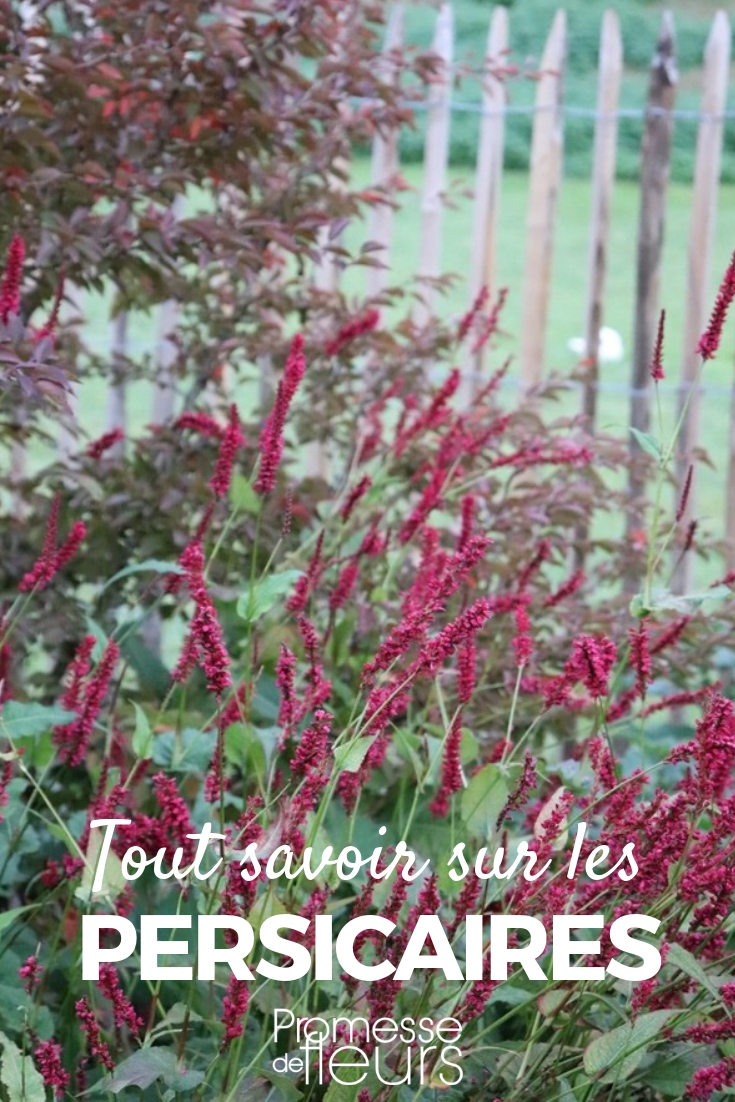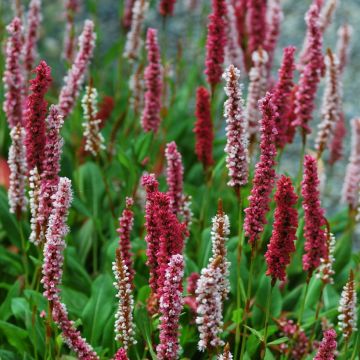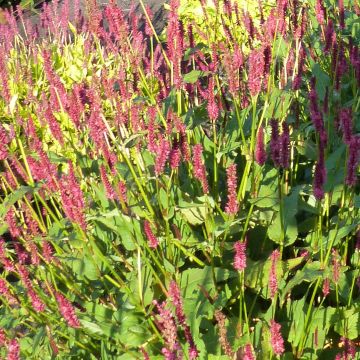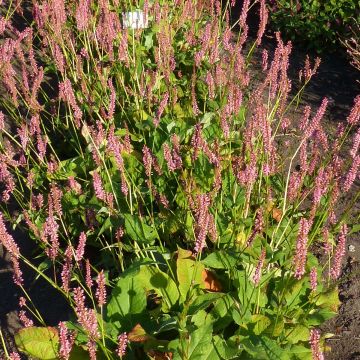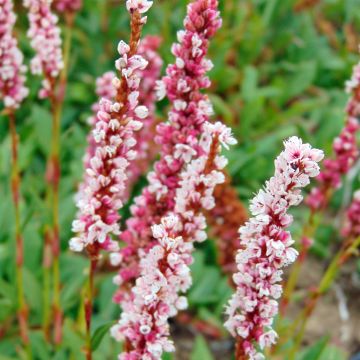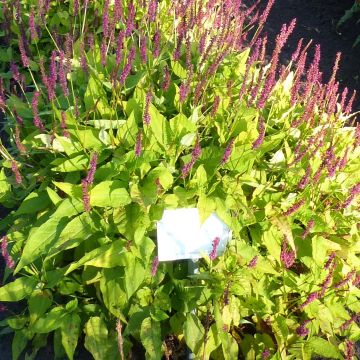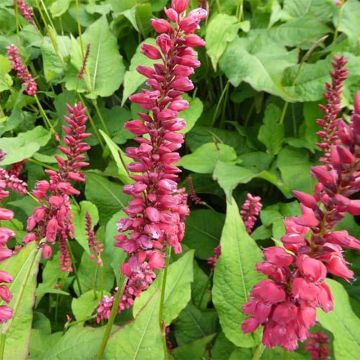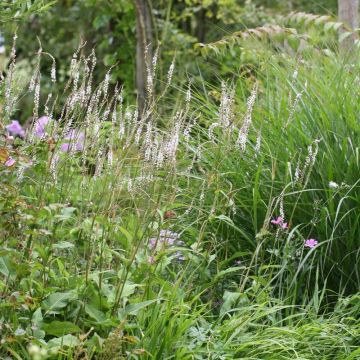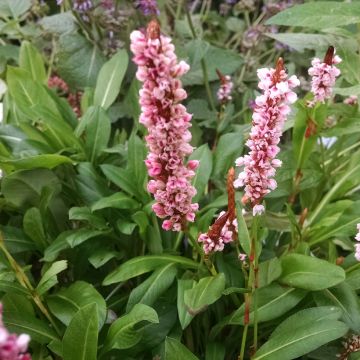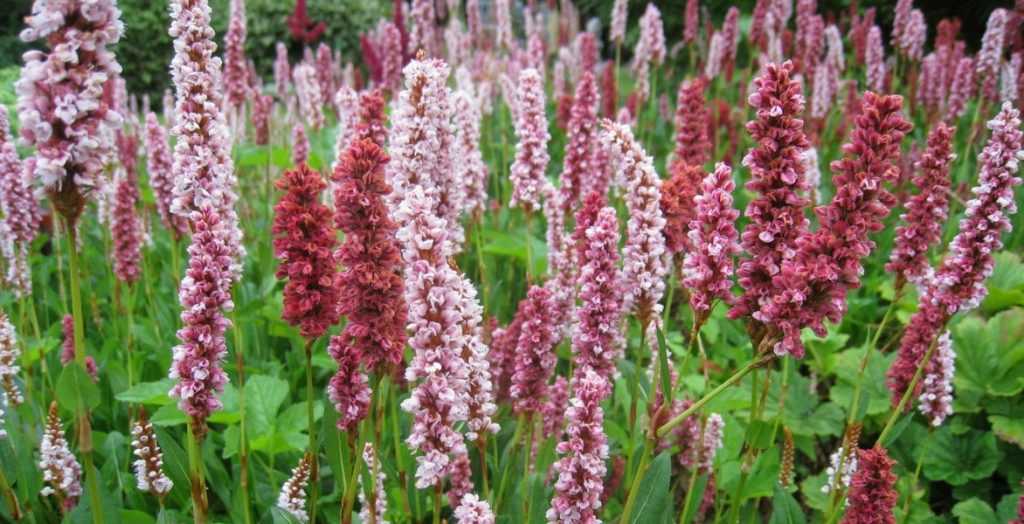
Persicarias or Knotweeds: Planting, Growing and Care
Contents
Persicarias in a Nutshell
- Persicaria or Knotweed offers a very long and beautiful flowering period, bringing lightness and graphic appeal to your borders from early summer for four months!
- Planted alongside ornamental grasses, it helps create stunning contemporary gardens or naturalistic borders, reminiscent of wild meadows.
- Sometimes mistaken for invasive plants, Persicaria poses little risk and is easily controlled.
- Thriving in moist soil, it grows rapidly and requires minimal maintenance.
- Very vigorous and bushy, its dense foliage smothers weeds! It can therefore be used as a flowering ground cover even in challenging or shaded areas.
- There are many varieties to discover: the delicate, fine inflorescences of Persicaria filiformis, the intense red blooms of Persicaria amplexicaulis ‘Blackfield’, and the striking purple foliage of ‘Red Dragon’ Persicaria!
Our Expert's Word
Also known as Knotweed and Polygonum, the Persicaria is a stunning perennial that will delight you with its long and generous flowering period. From July onwards, it becomes covered in countless flower spikes, in pastel tones (pink, white) or red, lasting until the first frosts. Its very fine inflorescences, carried on tall stems, will give your garden a wild look. It pairs wonderfully with ornamental grasses to create contemporary or natural gardens. It adds lightness and elegance to your flower beds. Among the most well-known varieties, the Persicaria amplexicaulis ‘Blackfield’ stands out for its intense red blooms.
Some varieties feature highly decorative foliage, such as the Persicaria ‘Red Dragon’, which will captivate you with its striking purple leaves marked with silvery white. The Persicaria ‘Purple Fantasy’ boasts magnificent, highly contrasted and graphic triangular foliage. Most species have an upright habit, but some are ground-covering, like Persicaria affinis, and can be used as ground cover to effectively suppress weed growth.
Once well established, in sun or partial shade, in moist or even wet soil, Persicaria is particularly vigorous. Hardy, it requires little maintenance and proves resistant to diseases and pests.
Botany
Botanical data
- Latin name Persicaria sp.
- Family Polygonaceae
- Common name Knotweeds or Smartweeds
- Flowering white, pink or red, in spikes
- Height 25 cm for the smallest varieties, up to 1.20 m
- Exposure sun, partial shade
- Soil type moist, damp, rich
- Hardiness very hardy, -20 to -25°C
Persicarias are perennial plants that grow naturally in damp meadows, along watercourses, sometimes in woodland, in mountainous regions. There are even completely aquatic species, like Persicaria amphibia! Many species originate from the Himalayas, and more broadly from Asia, but some can also be found in France and North America. In France, you’ll mainly find Persicaria lapathifolia, Persicaria maculosa and Persicaria hydropiper (Water Pepper).
Often native to high-altitude wetlands, they thrive in moist soil – they can even be planted at pond edges! – and are very hardy, sometimes down to -25°C. Although easy to grow, they must be protected from drought, otherwise they may not flower. The soil should be rich and remain moist. Plant them in sunny or partially shaded positions. White-flowered varieties are best suited to shady spots.
Persicaria is also known as Smartweed. Formerly classified in the Polygonum genus, they have now been separated to take the name Persicaria. They comprise 100 to 150 species, mainly perennials, though there are also annual species like Persicaria orientalis. The name Persicaria comes from the Latin Persica, meaning “peach”, as its leaves resemble those of a peach tree. Persicaria belongs to the Polygonaceae family, which includes around 800 species mainly from temperate zones. Among them are rhubarb, buckwheat and sorrel!
These are vigorous plants that grow quite rapidly. If they sometimes suffer from a bad reputation, it’s because they’re related to two feared plants: Japanese Knotweed (Reynoutria japonica), which is invasive, and Redshank (Persicaria maculosa), a common weed in damp soil. However, most ornamental species cause no problems! Persicaria amplexicaulis grows in clumps and isn’t invasive at all. For the more vigorous varieties, the issue can easily be solved with a rhizome barrier. It would be a shame to miss out on these plants! Their rapid growth and spreading ability should instead be exploited. This allows quick establishment of dense clumps that suppress weeds, making them quite easy to grow.
Persicarias generally have an upright clump-forming habit. They produce dense, compact foliage at the base, from which erect stems emerge, sometimes very tall, bearing flowers at their tips.
The smallest species, like the ground-covering Persicaria affinis, reach about 25cm tall and can be used as ground cover. The tallest, like Persicaria amplexicaulis, grow in upright clumps and can reach 1.20m in height.
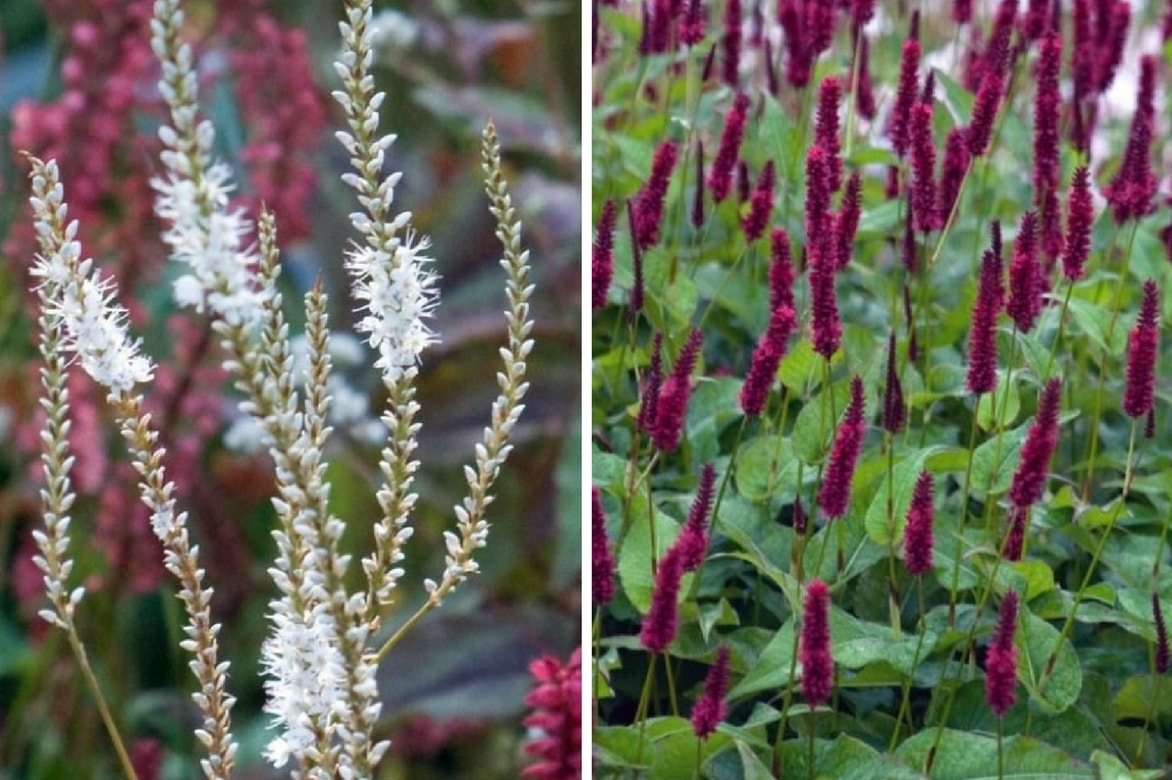
Persicaria amplexicaulis ‘Alba’ and Persicaria amplexicualis ‘Blackfield’
Persicaria offers generous flowering over a long period: from early summer (June-July) until the first frosts. The plant becomes covered in a multitude of white, pink or red flowers, grouped in often very fine, elongated spikes. These perch at the ends of long stems, giving the whole plant a very graphic and delicate appearance. These spikes consist of small five-petalled flowers.
Some species break this pattern. For example, Persicaria runcinata is one of the few Persicarias with short, rounded spikes. Persicaria orientalis has spikes that aren’t upright but drooping. And the inflorescence of Persicaria polymorpha, with its loose, airy panicles, strongly resembles that of Astilbes!
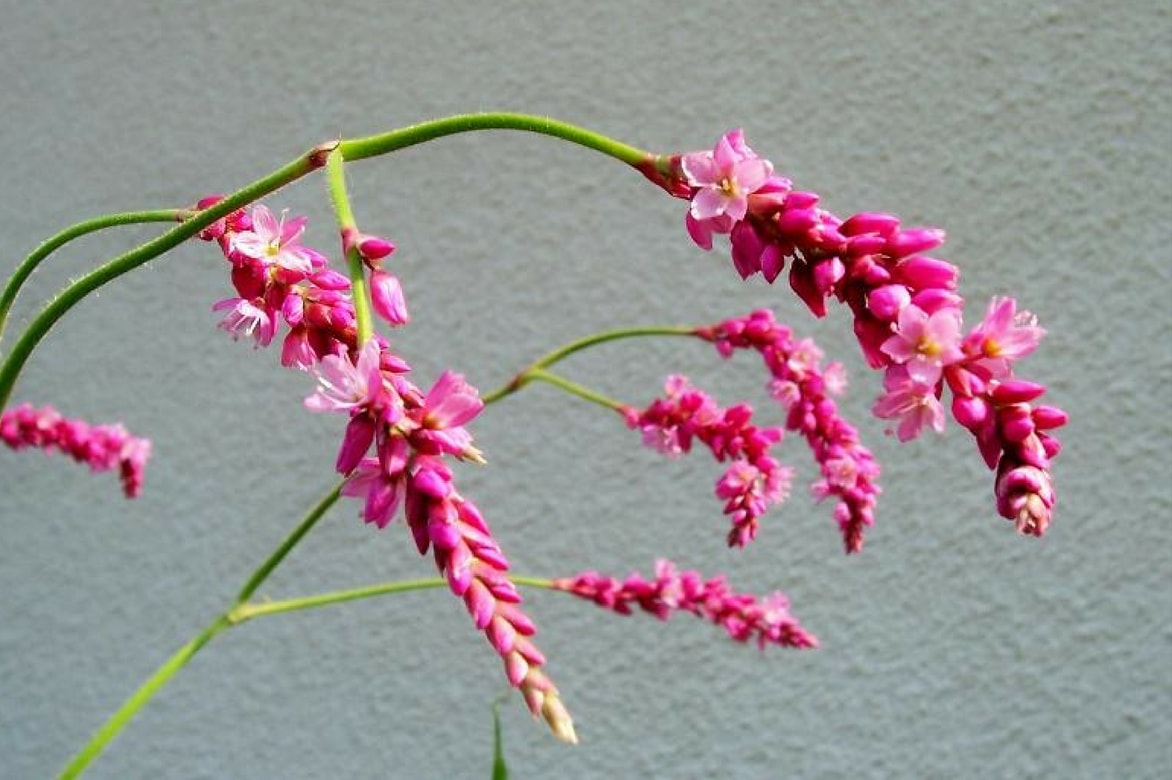
Persicaria orientalis
Persicaria leaves are often entire, with smooth edges and finely pointed tips. They can develop striking red hues in autumn. Most species are deciduous, losing their leaves in autumn. But some are semi-evergreen, like Persicaria campanulata.
Their leaves are sometimes very beautiful and unusual! Notable examples include the triangular, highly contrasted foliage of Persicaria ‘Purple Fantasy’ and Persicaria microcephala ‘Red Dragon’ (dark red), as well as the green and cream-white variegated leaves of Persicaria virginiana ‘Painter’s Palette’

Smartweed, highly decorative foliage: Persicaria filiformis / Persicaria virginiana ‘Painter’s Palette’ / Persicaria ‘Purple Fantaisy’ / Persicaria microcephala
Very vigorous, Persicaria spreads quickly via its rhizomes (underground horizontal stems). This helps it establish well but makes some species potentially invasive. Fibrous roots develop from these rhizomes.
Some species have practical uses as edible or medicinal plants. For example, Persicaria odorata is used in Asian cuisine, known as Rau ram or Vietnamese Mint. As for Persicaria tinctoria, the Dyer’s Knotweed, it’s used in Asia to extract indigo dye.
The main species of Persicaria
There are around a hundred botanical species of Persicaria, as well as numerous varieties. The botanical species are commonly cultivated in gardens.
- Persicaria amplexicaulis
Red bistort is a robust and non-invasive species. Native to the wetlands of the Himalayas, it can grow with its roots in water but also withstands brief summer droughts. It thrives in heavy, clay soils and does well at woodland edges. It produces tall stems and bears very attractive semi-evergreen leaves. Its flowers, clustered in spikes, are pink, red, or white. They give it a wild appearance, making this Persicaria ideal for naturalistic gardens. It is very hardy, tolerating temperatures down to –25°C.
- Persicaria affinis
Like Persicaria amplexicaulis, it originates from the Himalayas. This is a ground-covering species, quite low-growing but spreading easily. It blooms in dense spikes, ranging from pale pink to rose-red. Its lance-shaped leaves turn red-bronze in autumn. Tolerant of both drought and sun, it thrives in rockeries. It can also be planted in pots or borders.
- Persicaria filiformis
This species forms compact clumps and has very attractive green foliage speckled with brown. The foliage is deciduous. It gets its name from its long, thread-like flower spikes bearing small red flowers. It is also known as Persicaria virginiana var. filiformis.
- Persicaria bistorta
Common bistort grows quickly and bears spikes of pale pink flowers. It is naturally found in Europe, Asia, and North America, mainly in damp mountain meadows and along waterways. It therefore requires relatively moist soil and thrives at pond edges in cool, clay soils. It is often sold under the beautiful variety name Persicaria bistorta ‘Superba’.
This is a species worth discovering, still too little known! It bears panicles of delicate pale pink bell-shaped flowers. Its leaves, white on the underside, have very pronounced veins, making them particularly decorative. It spreads via stolons, forming large colonies at woodland edges. It requires moisture to thrive.
This is a small species originating from Japanese forests and woodlands. It has a creeping habit and forms compact, tufted clumps. It thrives in rockeries. It flowers early in spring, producing small spikes of white flowers.
Giant fleeceflower forms an enormous clump over time, reaching up to 2m in height. In summer, it produces stunning white corymbs of flowers that attract insects and butterflies. Watch it in action in this video:
The main varieties
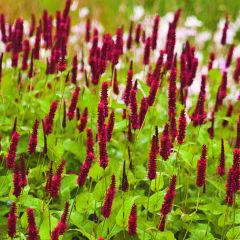
Persicaria amplexicaulis Blackfield - Mountain Fleece
- Flowering time August to November
- Height at maturity 80 cm

Persicaria microcephala Red Dragon - Knotweed
- Flowering time August, September
- Height at maturity 80 cm
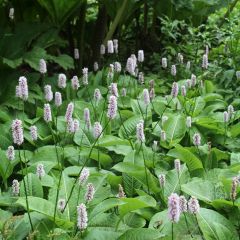
Persicaria bistorta Superba - Bistort
- Flowering time June, July
- Height at maturity 60 cm
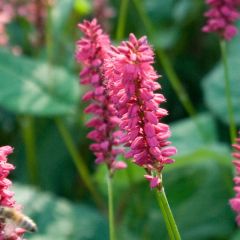
Persicaria amplexicaulis Taurus - Mountain Fleece
- Flowering time August to October
- Height at maturity 1 m
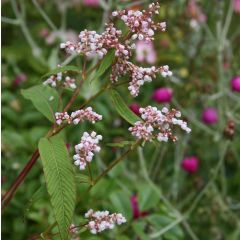
Persicaria campanulata
- Flowering time August to November
- Height at maturity 1,20 m
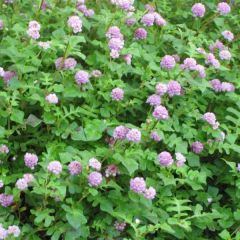
Persicaria runcinata Needhams Form - Knotweed
- Flowering time August to December
- Height at maturity 15 cm
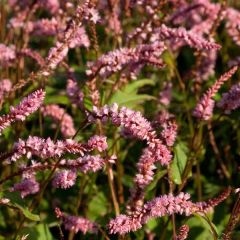
Persicaria amplexicaulis Pink Elephant - Mountain Fleece
- Flowering time July to December
- Height at maturity 40 cm
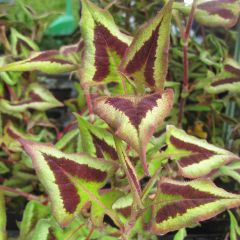
Persicaria runcinata Purple Fantasy - Knotweed
- Flowering time August to November
- Height at maturity 50 cm
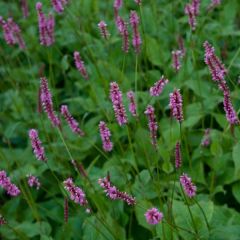
Persicaria amplexicaulis High Society - Mountain Fleece
- Flowering time August to November
- Height at maturity 1,20 m
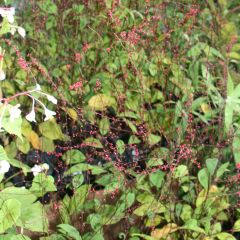
Persicaria virginiana var. filiformis - Virginia Knotweed
- Flowering time September to December
- Height at maturity 50 cm

Persicaria polymorpha - Knotweed
- Flowering time July to November
- Height at maturity 2 m
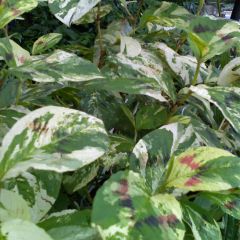
Persicaria virginiana Painters Palette - Virginia Knotweed
- Flowering time September, October
- Height at maturity 60 cm
Discover other Persicaria
Planting Persicaria
Where to Plant Persicaria?
Plant it in full sun or partial shade, in a sheltered spot away from wind. You can position it at the edge of woodland. Smaller Persicarias, such as Persicaria tenuicaulis, thrive in shade. Most species prefer rich, clay soils, which are heavy. If your soil is poor, you can improve it by adding compost. But the most important factor is that the soil remains moist, or even wet. Some Persicarias grow naturally along the banks of streams or ponds, so they will do well near water features. If planted in dry conditions, they may fail to flower and will struggle to establish.
The foliage of Persicaria microcephala ‘Red Dragon’ develops richer colours when planted in shade.
Vigorous and spreading, Persicarias need ample space to grow properly (especially if you install a rhizome barrier!). Avoid planting them in overly cramped borders.
Follow these tips to install a rhizome barrier.
Persicaria affinis ‘Darjeeling Red’, Persicaria tenuicaulis, and Persicaria vaccinifolia can be planted in rock gardens, provided the soil isn’t too dry.
When to Plant?
It’s best to plant Persicaria in autumn, between September and October, allowing roots to establish before winter. Spring planting, from April onwards, is also possible, but ensure regular watering in the first few weeks to encourage rooting.
How to Plant?
We recommend spacing plants 50 to 60 cm apart.
- Start by soaking the root ball in a bucket of water to improve establishment.
- Prepare the planting site by loosening the soil to a depth of 30–40 cm.
- If needed, install a rhizome barrier.
- Dig a planting hole roughly twice the size of the root ball.
- Fill the base with soil. We also recommend adding compost, as Persicaria thrives in fertile soil.
- Place the plant, ensuring the top of the root ball sits level with the ground.
- Backfill with soil, then gently firm it down with your hands.
- Water thoroughly.
- Continue watering regularly in the weeks after planting.
If planting Persicaria runcinata, Persicaria elata, or Persicaria polystachyum, install a rhizome barrier. Alternatively, divide them every few years to control their spread. Species like Persicaria polymorpha, Persicaria amplexicaulis, or Persicaria tenuicaulis are non-invasive and require no such measures.
Once established in moist soil, Persicaria grows rapidly. It can thrive for years with minimal care.
How to care for Persicaria?
Once well established, the persicaria requires very little maintenance. Hardy and resilient, it is rarely affected by diseases and pests. Only snails and slugs may occasionally nibble on its foliage, especially in spring when the young shoots are tender. Regular monitoring of these pests is usually enough to protect the plant.
It’s important to water during prolonged dry spells, as persicaria prefers the soil to remain moist. Mulching around the base can help retain moisture.
To prolong flowering, regularly deadhead spent blooms, which will encourage the plant to produce new flower stems. In autumn, cut back the clump to promote stronger regrowth the following spring.
Over the years, when the clump becomes very dense, it’s advisable to divide the rhizomes to rejuvenate the plant and give it more room to grow. If your persicarias become too invasive, don’t hesitate to divide them to control their spread.
When handling persicarias, remember to wear gloves, as their sap can be slightly irritating to the skin. With these simple steps, your persicaria will continue to enhance your garden with minimal effort!
How to propagate it?
Some Persicarias can self-seed spontaneously, particularly Persicaria orientalis or Persicaria virginiana. For instance, Persicaria orientalis tends to self-seed abundantly in autumn. As an annual species, it can persist in the garden this way. To propagate Persicaria, we recommend rhizome division rather than cuttings. You’ll obtain a bushy, flowering plant much more quickly.
Rhizome Division
You can easily propagate Persicarias by dividing their rhizomes in spring or autumn. This not only produces new plants but also helps control the growth of existing ones, which can sometimes be overly vigorous. By dividing and replanting the rhizomes, you’ll gradually cover large areas and enhance parts of your garden.
- Start by digging up the clump with a spade.
- Gently shake off excess soil clinging to the rhizomes.
- Separate the rhizomes with a knife, ensuring each new plant retains some roots.
- If needed, trim stems or remove leaves to balance root and foliage growth.
- Place each rhizome in a pot filled with compost.
- Water generously.
- Simply place the pot under shelter.
Cuttings
Persicaria is very easy to propagate from cuttings. Take cuttings in spring, between May and July.
- First, prepare a pot by filling it with moist substrate.
- Take a 10 cm stem cutting. Make a clean cut with a knife just below a node (where a leaf joins the stem).
- Optionally remove one or two lower leaves.
- Make a hole in the pot with a dibber.
- Insert the cutting.
- Gently firm the substrate around the stem.
- Keep the pot under shelter in a bright, warm spot, and ensure the substrate stays moist.
How to pair Persicaria?
With its delicate and airy blooms, Persicaria is ideal for creating naturalistic borders. Its soft, ethereal habit allows for meadow-like compositions when paired with ornamental grasses such as Miscanthus or Stipa, adding movement and texture. These combinations evoke wild landscapes, striking a perfect balance between lightness and structure – ideal for modern gardens seeking a spontaneous, flowing aesthetic.
Persicaria isn’t limited to naturalistic plantings. Thanks to its vertical lines and freeform habit, it integrates beautifully into contemporary, graphic gardens. It creates striking contrasts when combined with more rigidly structured plants like topiary box balls or strictly linear conifers. This interplay between Persicaria’s loose forms and geometric shapes brings originality and modernity. Try pairing it with clipped hedges or living sculptures for sophisticated displays.
In another setting, Persicaria thrives at woodland edges. It brings light and contrast when planted near lush foliage like Hostas or Japanese Anemones. These combinations play with subtle contrasts between foliage and flowers, creating harmonious pastel tones and textural interplay.
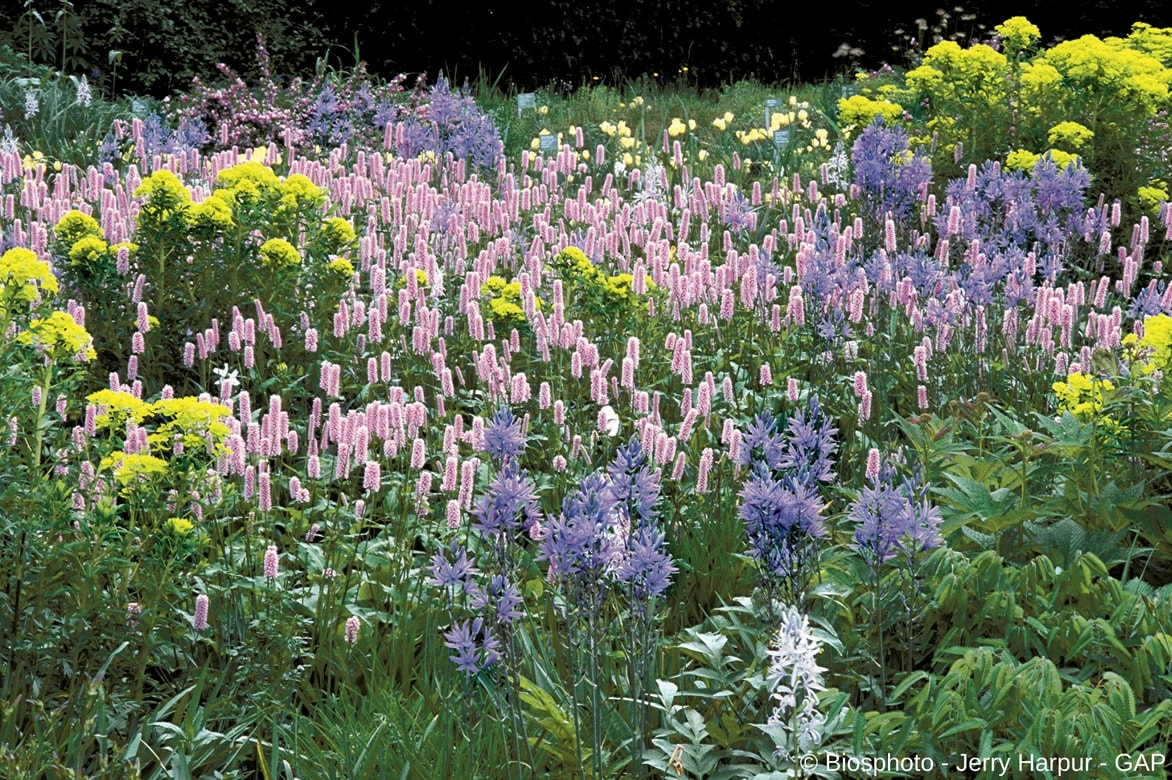
Persicaria bistorta ‘Superba’ – Euphorbia palustris – Camassia leichtlinii ‘Caerulea’
With its majestic, lush growth, Persicaria polymorpha naturally suits exotic gardens. Pair it with hardy palms, giant-leaved Gunnera, or tree ferns to enhance its luxuriant, tropical character. Its substantial flower plumes create dramatic volume in exuberant plantings.
Other varieties like Persicaria runcinata ‘Purple Fantasy’ or Persicaria microcephala ‘Red Dragon’ are prized for their decorative foliage. The striking purple-marked leaves of ‘Red Dragon’ combine beautifully with the dark blooms of Geranium phaeum, creating bold graphic effects and striking colour contrasts. These Persicarias are perfect for adding drama and originality to borders through deep hues and intriguing textures.
Discover more planting ideas in our guide: “Persicaria or Knotweed: 10 Successful Planting Combinations”
Useful resources
- Our wide range of Persicarias on our website.
- A very good article by Didier Willery, published in L’Ami des Jardins et de la maison
- A video about growing and dividing Persicaria amplexicaulis
- A video to learn how to control an invasive plant
- A video about Persicaria polyphorma
- Our advice sheets: Choosing a Persicaria, 7 white-flowered Persicarias, 7 red-flowered Persicarias, 7 pink-flowered Persicarias
- Subscribe!
- Contents
